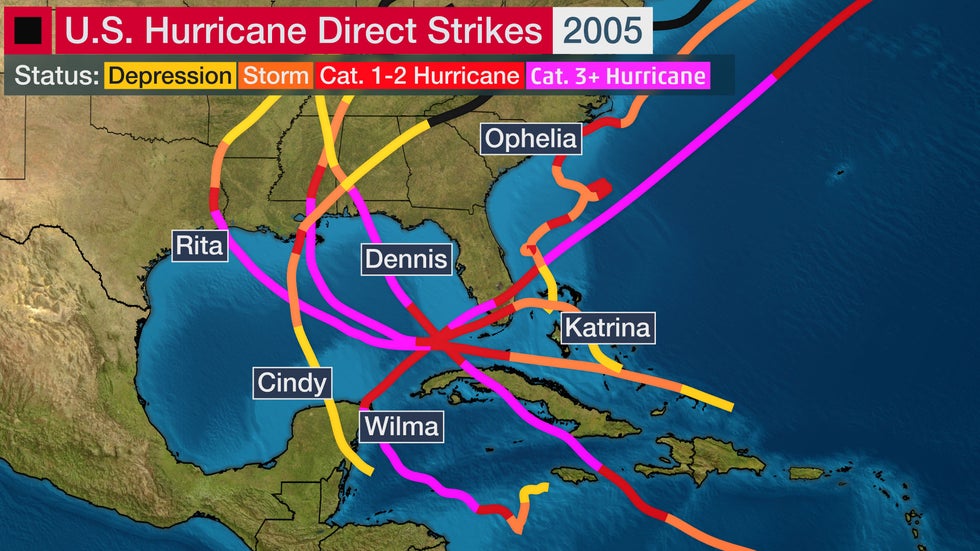 The tracks for the 28 storms in the Atlantic in 2005. All of these storms had at least tropical-storm-force or hurricane-force winds at their peak intensity.
The tracks for the 28 storms in the Atlantic in 2005. All of these storms had at least tropical-storm-force or hurricane-force winds at their peak intensity.The most extreme Atlantic hurricane season in the satellite era began 15 years ago this June, when more than two dozen storms wreaked havoc over seven months in virtually every corner of the ocean basin.
There were 28 storms in the hyperactive 2005 hurricane season, which is the most on record for the Atlantic Basin. All 21 of the names on the Atlantic list for that year were used up by mid-October when Wilma developed. For the first time in history, Greek alphabet names (Alpha, Beta, etc.) were given to the remaining storms that formed through December.
Below we take a look at the record-breaking 2005 season by the numbers.
15
A record 15 hurricanes formed in the 2005 season, and seven of those reached major hurricane status (Category 3 or stronger on the Saffir-Simpson Hurricane Wind Scale). The previous record was 12 hurricanes in the 1969 and 2010 seasons.
213
The season lasted 213 days from the first advisory issued for Tropical Depression One on June 8, 2005, to the final advisory issued for Tropical Storm Zeta on Jan. 6, 2006. This is a span of nearly seven months.
126.25
The combined number of days with a named storm in the Atlantic basin during the 2005 season was 126.25. This broke the previous record of 125.25 named storm days set in 1933.
6
Six hurricanes made a direct strike on the U.S in 2005: Cindy, Dennis, Katrina, Ophelia, Rita and Wilma. All of those hurricanes made a U.S. landfall except Ophelia, which was classified as a direct strike since its circulation center stayed just offshore of eastern North Carolina, but still brought sustained winds up to hurricane force.
 The six hurricanes that made a direct strike on the U.S. in 2005.
The six hurricanes that made a direct strike on the U.S. in 2005.882
Hurricane Wilma set a record for the lowest barometric pressure ever recorded in the Atlantic basin on the morning of Oct. 19, 2005. The pressure reading of 882 millibars was recorded while Wilma was a Category 5 in the western Caribbean.
Barometric pressure is used to help measure the intensity of a hurricane. In general, the lower the pressure in a hurricane, the stronger its winds.
Another interesting fact about this historical moment was that the diameter of Wilma's eye had shrunk to just two nautical miles wide.
 Wilma and its pinhole eye on the morning of Oct. 19, 2005.
Wilma and its pinhole eye on the morning of Oct. 19, 2005.1,200
Hurricane Katrina was responsible for about 1,200 deaths, according the National Hurricane Center.
Even though Katrina had weakened to a Category 3 before landfall along the northern Gulf Coast, its large size and previous extreme intensity sent a huge storm surge into the Mississippi, southeast Louisiana and Alabama coasts. The surge left behind catastrophic destruction along the coast of Mississippi and stressed the levees protecting New Orleans, causing them to fail. That resulted in an inundation of 80 percent of New Orleans with water depths up to 20 feet.
 Complete devastation from Hurricane Katrina's storm surge in Waveland, Mississippi. (Credit: NOAA)
Complete devastation from Hurricane Katrina's storm surge in Waveland, Mississippi. (Credit: NOAA)27.8
The maximum storm surge from Hurricane Katrina was measured at a record height of 27.8 feet in Pass Christian, Mississippi. Storm surge was able to move inland up to six miles and crossed Interstate 10 in many areas, according to the National Hurricane Center.
224,400,000,000
The total damage cost for the four major hurricanes that made a U.S. landfall in 2005 was in excess of $224 billion (adjusted for inflation), according to NOAA. A large amount of this was caused by Hurricane Katrina, which cost an estimated $170 billion alone.
5
The names of five hurricanes were retired after the 2005 hurricane season.
Four of those hurricanes – Dennis, Katrina, Rita and Wilma – caused significant amounts of damage in the United States. The fifth hurricane name retired was Stan, which caused disastrous flooding in Mexico and Central America.
The lists of names for Atlantic storms are rotated every six years. Storms that cause a significant amount of property loss or deaths can be retired by the World Meteorological Organization.
4
A record four hurricanes reached Category 5 status in the 2005 season. That includes Hurricanes Emily, Katrina, Rita and Wilma.
Emily was the record earliest-forming Category 5 hurricane in the Atlantic. It strengthened into a Category 5 on July 16 while in the Caribbean Sea, just to the south of Jamaica.
 The eye of Hurricane Emily in the Caribbean Sea as seen from the International Space Station on July 17, 2005.
The eye of Hurricane Emily in the Caribbean Sea as seen from the International Space Station on July 17, 2005.The Weather Company’s primary journalistic mission is to report on breaking weather news, the environment and the importance of science to our lives. This story does not necessarily represent the position of our parent company, IBM.
The Weather Company’s primary journalistic mission is to report on breaking weather news, the environment and the importance of science to our lives. This story does not necessarily represent the position of our parent company, IBM.

No comments:
Post a Comment